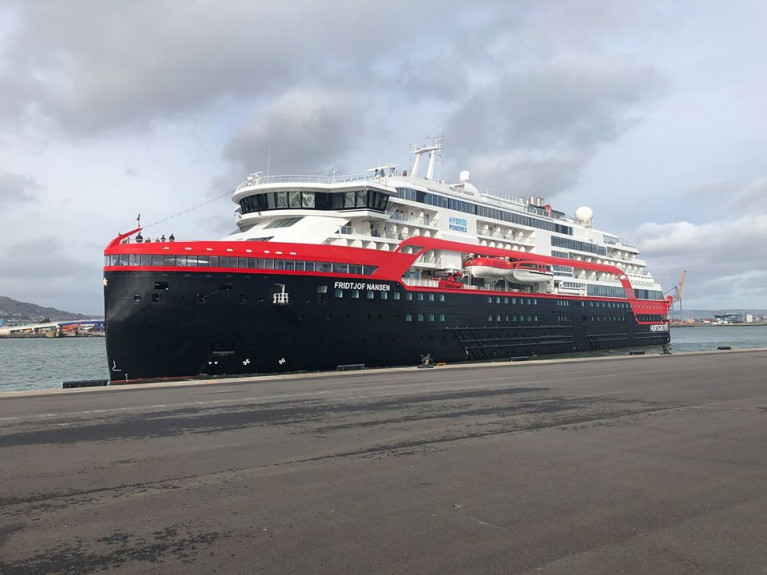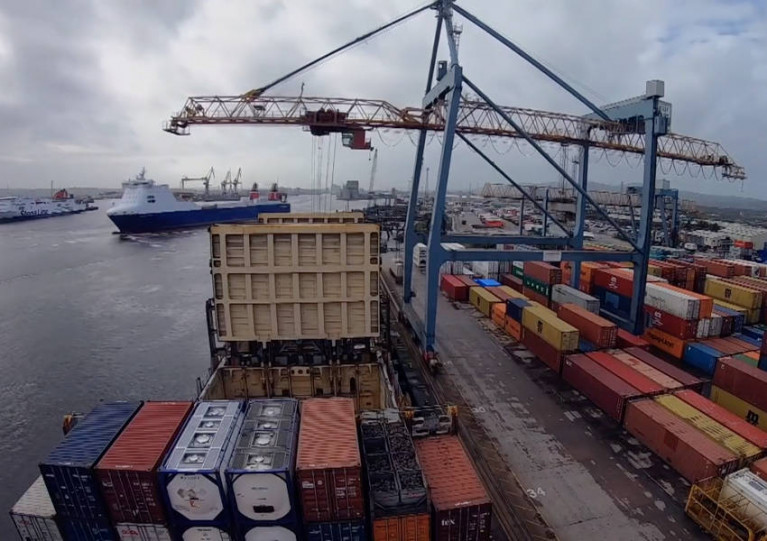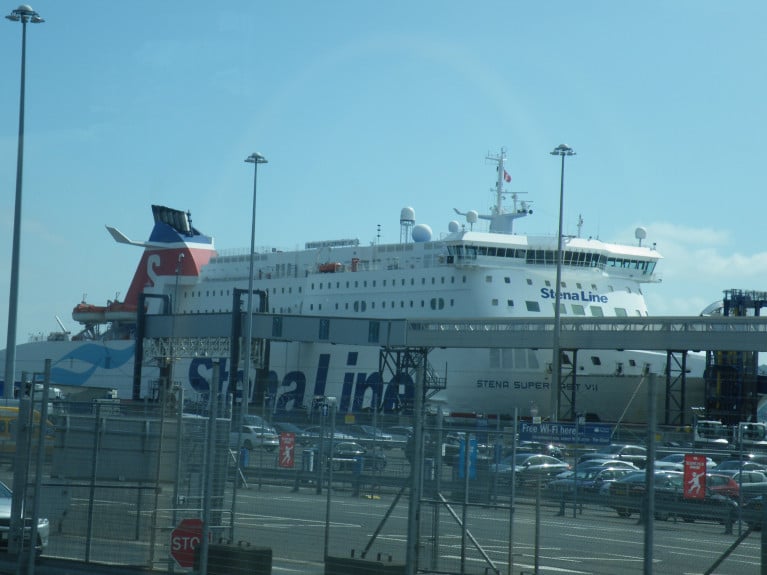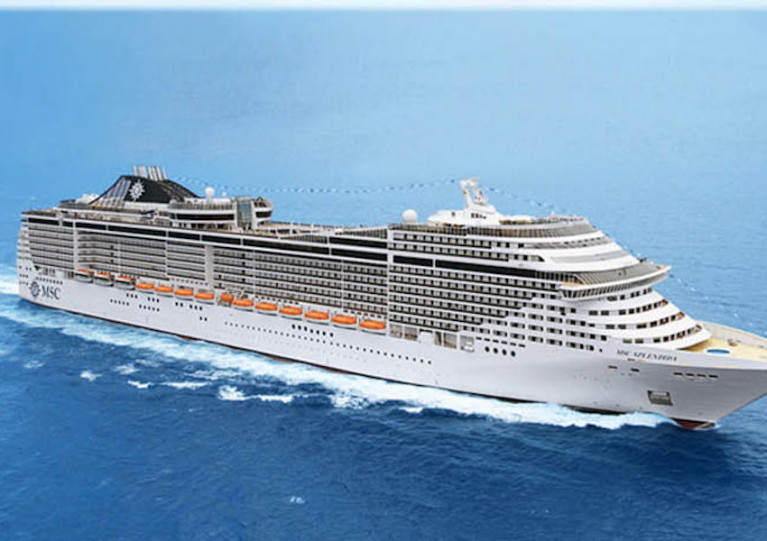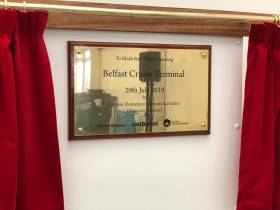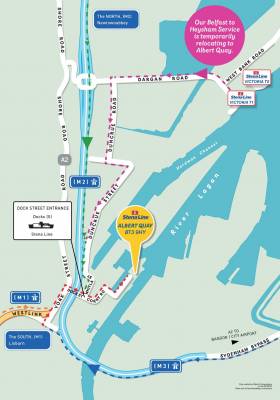Displaying items by tag: Belfast Harbour
Cruise Collapse As Belfast Harbour Takes hit But Pledges to Continue Major Investment Projects
Cruise fall-out as Belfast Harbour is anticipating that Covid-19 could hit revenues by as much as 20% this year, largely due to the collapse of its cruise, tourist and leisure business.
Port bosses said they do not expect any of the scheduled cruises to arrive in Belfast this year, with plans for a new cruise terminal now on hold.
Just one ship docked (as Afloat reported) in the city in 2020 prior to the coronavirus pandemic.
Some 130 were originally booked, expected to bring around 230,000 tourists to Belfast.
Chief executive Joe O’Neill said it could be 2022-23 before the cruise business recovers.
Belfast Harbour confirmed that its revenues and profits were already down in 2019, prior to the Covid-19 pandemic.
More from The Irish News here.
Belfast Harbour Has Starring Role In New BBC Documentary Series
A new TV series beginning tomorrow night (Tuesday 14 April) on BBC One Northern Ireland puts Belfast Harbour in the starring role.
Today’s Belfast Telegraph features the three-part documentary, Belfast Harbour: Cruises, Cranes and Cargo, which was filmed in the busy port last autumn.
And it captures the highs and lows of a time that saw both the arrival of the city’s biggest ever cruise liner visitor, and a closure threat to the iconic Harland & Wolff shipyard.
Future episodes will explore the work of the harbour’s control room managers and shipping agents who oversee the movement of a dizzying array of goods in and out of the port.
That’s not to mention the skilled harbour pilots and crane operators who help to ensure its safe workings day in and day out.
The first episode of Belfast Harbour: Cruises, Cranes and Cargo screens Tuesday 14 April at 10.45pm on BBC One NI. The Belfast Telegraph has more on the story HERE.
Ferry operator Stena is reducing its Belfast Harbour services as a result of the coronavirus pandemic.
The firm, which normally operates seven ships on 138 sailings a week from Belfast, has temporarily berthed one ship (Afloat tracked to ro-ro freighter Stena Forecaster) and cut sailings to 108 a week.
Earlier this week, the firm said it would furlough staff and make redundancies across its UK and Ireland operations.
Stena sails from Belfast to Heysham, Liverpool and Cairnryan.
It is understood freight volumes have fallen since the crisis began but that non-freight traffic has collapsed.
More on this BBC News story here including what is happening to the ferry sector serving the Republic when yesterday Afloat reported the Irish government approved an “emergency provision” of a maximum of up to €15m (£13.2m).
This is the cost of maintaining five passenger ferry services in response to Covid-19.
Cruise Liner Bound For Belfast Rerouted From Italian Ports Over Nationwide Covid-19 Lockdown
A cruise liner bound for Belfast in May has had its itinerary changed to avoid two upcoming port calls in Italy, following that country’s extraordinary national lockdown measures to control the coronavirus pandemic.
According to the Belfast Telegraph, the MSC Splendida was due to dock at Civitavecchia on Saturday 28 March and the following day at Genoa.
However, with quarantine extended to the whole of Italy by its government this past Monday (9 March), MSC Cruises has rerouted the ship to instead dock in Marseille in 28 March and Barcelona on 29 March.
The MSC Splendida is expected to arrive in Belfast Lough on Friday 1 May via Hamburg.
The Belfast Telegraph also reports that a major cruise operator hit hard by Covid-19 outbreaks, and which was due to bring 5,000 people to Belfast on Friday 8 May, has suspended operations for the next eight weeks.
Princess Cruises, whose Diamond Princess in Japan and Grand Princess in California were subjected to quarantine, also operates the Regal Princess — which is at present approaching Cozumel in Mexico to end its current voyage.
Belfast Harbour has submitted a planning application for the development of six new purpose-built film and television studios at its existing Giant’s Park site.
The harbour company says the plans represent an investment of £45m and will generate 250 construction jobs and around 1,000 creative industry jobs.
The proposed development would quadruple the size of the Belfast Harbour Studios complex and make Belfast a leading centre in the industry, the company says.
Phase one of the Belfast Harbour Studios development opened three years ago at Giant’s Park on Belfast Lough with two 32,000 sq ft studios and 125,000 sq ft of overall production space.
These have been used for a number of major productions including SyFy’s Krypton TV series and are currently occupied by a major film production company.
Belfast Harbour now intends to develop four additional 21,000 sq ft studios and two 16,000 sq ft studios, as well as up to 100,000 sq ft of production offices and 130,000 sq ft of support workshops on an adjoining 20-acre site.
In total, the project represents more than 346,000 sq ft of additional production facilities which, when combined with phase one, will create the largest studio complex outside of the South East of England.
Located on Belfast’s Giant’s Park on the North Foreshore, the expanded facility will also provide flexible backlot areas and dedicated support space for specialised creative suppliers to the industry, and aligns with Belfast Harbour’s ambitions to create a leading European media hub.
Joe O’Neill, Belfast Harbour’s CEO, said: “In recent years Belfast has established itself as one of the UK’s top media production hubs. In 2017 we invested £20m to provide brand-new studio facilities but with record levels of demand for studio space globally, we are confident the time is right to progress with phase two of the development.
“The location is highly accessible, is serviced by ultra-high-speed internet connections and benefits from a skilled local workforce that has proven its ability to help deliver some of the world’s best film and television content.
“This new studio complex will build on Northern Ireland’s already impressive international reputation and generate around 1,000 creative industry jobs across a wide variety of disciplines.”
Upon receipt of planning, Belfast Harbour would start construction on phase two later this year with completion of the new studios scheduled for 2021.
Richard Williams, CEO of Northern Ireland Screen, said the expansion would provide a significant further boost for the local industry at a time when studio space is at a premium across the UK.
“With Disney and Apple joining Netflix and Amazon in investing in the launch of their own on-demand streaming services, there is no end in sight to the demand for high-end, high-cost content. That has led to unprecedented demand for studio space globally, so Belfast Harbour’s announcement comes at a perfect time for our local industry,” he said.
“Belfast Harbour’s support for the screen industries in Northern Ireland is exemplary, and their vision for phase two of Belfast Harbour Studios is inspired. It is a development that will help Northern Ireland to become the largest screen sector in the UK and Ireland outside of the southeast of England.”
Spending on film and high-end television in the UK from major international productions topped £3.04bn in 2019, according to figures released by British Film Institute’s research and statistics unit.
Port of Belfast Trade Remains Strong
For the second year running the Port of Belfast trade tonnages handled during 2019 have remained strong at more than 24M tonnes.
Positive growth was recorded in several sectors including Roll-on / Roll-Off (Ro-Ro) freight vehicles and exports of aggregates, while last year’s more favourable weather conditions led to lower imports of grain, animal feeds and fuels.
Ro-Ro units rose by 4% to a record 542,000, reflecting the continued popularity of Stena Line’s freight traffic routes to Scotland and England. Exports of stone by Co Down based Conexpo for GB and European infrastructure projects exceeded 1M Tonnes for the first time. Tonnages in the wider aggregates sector grew by 4% to a record 1.6M Tonnes.
Northern Ireland’s tourism sector also benefitted from record numbers of cruise and ferry passenger numbers, up by 6% to over 1.6M, the highest figure recorded in 16 years. The number of tourist coaches carried also increased by 10% to a record 10,000.
Joe O’Neill, Belfast Harbour’s CEO, said: “Although there has been prolonged uncertainty about Brexit’s implications for Northern Ireland, port-related trading activity within the local economy has been steady with tonnage levels staying above 24M Tonnes for the second consecutive year. This reflects Belfast Harbour’s highly diversified and resilient business model which enables us to operate across every major cargo sector.
The 2019 figures also revealed that container traffic increased by 2%, surpassing the 130,000 units handled threshold for the first time since 2008.
Port Director, Michael Robinson added: “Over the longer-term, the mix of trades handled by the port will continue to evolve as consumer spending habits change and the drive to decarbonise the economy accelerates. “While this will lead to a decline in fossil fuel imports which have been a staple of the port industry for the last century, it also presents opportunities to further develop trades related to the green economy and sectors such as offshore wind where Belfast Harbour has a proven track record.
Belfast Harbour is Northern Ireland’s leading gateway and key economic hub for trade and tourism, handling more than 70% of the region’s seaborne imports and exports. The 2,000-acre Harbour Estate hosts more than five million annual visits, including 1.6 million ferry and cruise ship passengers. It is also home to a vibrant mix of 760 businesses working across multiple sectors, including marine logistics and heavy engineering, commercial and residential real estate, retail, financial and IT services, tourism and leisure, media and creative industries. The 85 berth Belfast Harbour Marina is located just upriver from the commercial port and is popular with visitors and long-term berth holders alike.
The ongoing £250million 5-year investment programme in port infrastructure and real estate projects will help deliver Belfast Harbour’s vision to be the world’s best regional port, upholding the highest environmental standards and adopting innovative smart technology and digital infrastructure.
A captain found drunk in charge of his ship in Belfast docks has been fined £500, as the Belfast Telegraph reports.
Fifty-eight-year-old Oleg Okolobvich was arrested after fellow crew were forced to step in to avoid the cargo vessel Danica Hav colliding with the quay at Belfast Harbour on Tuesday (14 January).
Belfast Magistrates' Court heard on Wednesday (15 January) that a ship’s pilot reported strange behaviour from the captain — who later failed a breath test after his arrest.
The Belfast Telegraph has more on the story HERE.
A dedicated cruise terminal the first on the island of Ireland, reports ITV News, has opened in Belfast.
A partnership between Visit Belfast and Belfast Harbour, the terminal has been created to cater for the growing number of cruise passengers visiting the city in recent years.
More than £500,000 has been invested in upgrading the facility in the Titanic Quarter which now includes a Visitor Information Centre.
The money has been invested by Belfast Harbour with funding also coming from Tourism NI. The centre will be managed by staff from Visit Belfast.
Captain of the Crown Princess, Domenico Lubrano Lavadera, opened the terminal alongside tourism officials and the Lord Mayor of Belfast John Finucane.
More on the story can be read through this link.
Stena Line to Temporarily Relocate Belfast-Heysham Service Terminal in Belfast Harbour
In preparation for the arrival of Stena Line’s new generation E-Flexer ships as Afloat previously reported onto the Belfast-Liverpool service in 2020/21, the company has announced the need to make a number of important infrastructure upgrade changes in Belfast Harbour.
According to the operator this involves Victoria Terminal 2 (VT2) where the arrival of the first new vessel (on this route) Stena Edda is scheduled in Spring 2020.
To minimise customer disruption and inconvenience whilst this work is being carried out, Stena Line has made temporary arrangements to relocate its Belfast – Heysham Service to Albert Dock/Ballast Quay for approximately 6 months, starting this week on Friday 14th June, 2019.
Anna Breen, Stena Line’s Freight Commercial Mangere (Irish Sea North) said: “ Whilst we fully appreciate the slight inconvenience this may cause, Albert Dock/Ballast Quay is a facility we have used before and are very familiar with so we will do all we can to minimise any possible inconvenience to our customers. As we invest and grow our business on the Belfast -Liverpool service, the new E-Flexers will provide an additional 20% freight capacity, hopefully this will provide even greater business development opportunities for our customers in the years ahead. Stena Line has a proven track record of investing in its ships and ports and nowhere is this more evident than in our expanding Belfast Hub. “
A map (as above) outlines the most convenient way to access the new temporary facility at Albert Quay (located closer to Belfast city centre).
Customers who require further information or clarification are advised to contact the Stena Line Customer Service Team on 0845 0704000
Mexican tall ship Cuauhtémoc is the star attraction at the Belfast Titanic Maritime Festival which continues till tomorrow, Monday 27 May.
The sail training ship is among the host of vessels — including Naval Service OPV LÉ Samuel Beckett — docked in the city’s harbour this weekend.
Belfast Live has all you need to know for how to get there and what to do among the wide array of activities, which this year spread across the Lagan from Queen’s Quay and the Titanic Quarter to Donegall Quay and the historic Sailortown district.
That maritime history is also the subject of a new exhibition charting a pioneering ID card system introduced for merchant seamen during the First World War.
Some 60 Sailortown locals have been identified among the cards that were discovered by David Snook while researching his own grandfather’s history, as BBC News reports.
The exhibition is currently on display at St Joseph's Church on Prince’s Dock Street.


























